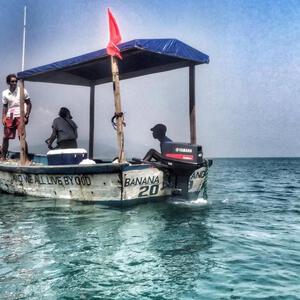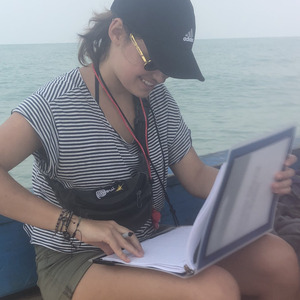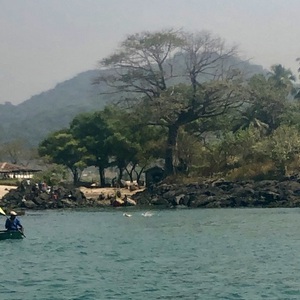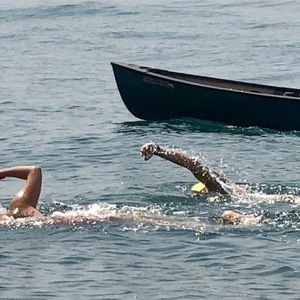Louise Twining-Ward and Qing Li - Kent (Sierra Leone) to Ricketts (Banana Islands)

Kent (Sierra Leone) to Ricketts (Banana Islands)
10 km (6.2 miles)
5 hours, 16 minutes on 8 February 2020
Observed and documented by Sophie Bes
First documented swim.

Contents
Swimmer
| Swimmer | Gender | Nation | Age | Hometown |
|---|---|---|---|---|
| Louise Twining-Ward | female | U.S. | 51 | New York, NY |
| Qing Li | female | U.S. | 30 | Chicago, IL |
Support Personnel
- Wissam Sfeile - Swim Director
- Emily Stanger Sfeile - Safety/Communication Coordinator
- Sophie Bes - Observer
- Capt Moses Willimans - Pilot
- Capt Ousman Jalloh - Kayak Support 1,
- James Toraney - Kayak Support 2
- Sam Verge - Support Crew/Social
- Elise Maceratini - GIS Planning and Support
- Eleanor Abdulai - Charity Affiliate (Disability Empowerment Movement Sierra Leone, demsl.org)
Escort Vessel: And We All Live By God (Bafa Resort, Dublin)
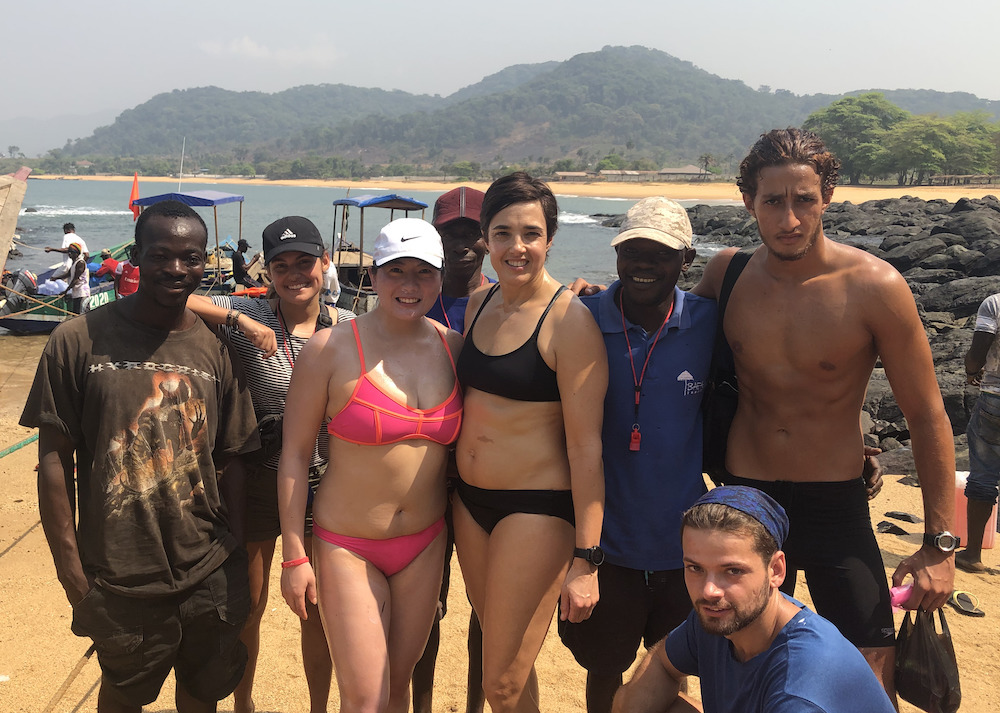
Swim Parameters
- Category: Solo, nonstop, unassisted.
- Rules: MSF Rules of Marathon Swimming, without exception or modification.
Equipment used
- Louise: 2-piece swim suit, 1 cap, 1 google, sun screen, vaseline.
- Qing: 2-piece swim suit —> changed to 1-piece after 30min, 1 cap, 1 google, sun screen, vaseline.
Route Definition
- Body of Water: Yawri Bay
- Route Type: one-way
- Start Location: Small unnamed beach near the point southwest of Kent Beach. Kent, Sierra Leone. (8.175086, -13.164808)
- Finish Location: Small cove near the northeastern tip of Ricketts Island. (8.110690, -13.219259)
- Minimum Route Distance: 10 km (6.2 miles) (map)

History
No known previous swims of this route.
Swim Data
- Start: 8 February 2020, 11:50 (Africa/Freetown, UTC+0).
- Finish: 8 February 2020, 17:06
- Elapsed: 5 hours, 16 minutes.
Summary of Conditions
| Feature | Min | Max |
|---|---|---|
| Water Temp (F) | 80 | 84 |
| Air Temp (F) | 77 (daily low, Lungi Airport) | 90 (daily high, Lungi Airport) |
| Wind (mph) | 3 (daily low, Lungi Airport) | 14 (daily high, Lungi Airport) |
GPS Track
Download raw data (CSV).
Speed Plot
Nutrition
- Louise: On the half-hour, Carbo-Pro+tropical juice mix. On the hour: Coconut drink + 1 gu.
- Qing: On the half-hour, Ultima electrolyte drink. On the hour, Virtargo carb drink + 1 gu.
Treat on occasion: 1 packet of SKRATCH LABS Sport Energy Chew
Observer Log
Narrative - Louise
The idea for this swim was born, like many swims, on a boat ride to an island. I had been working in Sierra Leone on and off for two years, giving me the chance to visit some of the country’s offshore islands. There was something special about the Banana Islands. On one of my trips to the Island about a year ago, I asked Captain Moses Williams, an elderly boat captain, if anyone had ever swum from the mainland to the Banana Islands. There was both sadness and pride in his cloudy eyes when he recalled the story. At the age of 19, he tried to escape household chores by joining an already overladen boat to the mainland for some weekend partying. Tragically a storm hit when the wooden boat was only halfway across the channel. Moses was one of the few on the boat who could swim. Remembering how his father always told him the currents close to the mainland were too fierce to swim, he decided to head towards Dublin, the closest Banana islands, at least three miles away. Incredibly, fully clothed and with no ocean swimming experience he made it to the island, raised the alarm, and four of the 28 people aboard were finally saved. I asked him if I could honor his achievement by coming back and swimming the channel with him as my boat captain. A big smile broke across his weathered face and he gave me the thumbs up. In that moment, I knew I had to make it happen.
Sierra Leone is in many ways the unknown South Pacific of West Africa. With a continental shelf stretching several miles off shore, it boasts calm white sand beaches, which reach into green tropical mountain rainforest––giving rise to the blue-white-green of the national flag. Despite its natural beauty,the country is still way off the beaten track for both travelers and swimmers; about a six-hour flight from Paris or Brussels; about 15 hours from the East coast of the United States to Lungi International Airport. To reach Freetown from the airport you must head to the beach and board a small boat, luggage and all— great experience for a swimmer (less so for non-swimmers). But years of civil war and the Ebola virus had made it hard for the country’s budding tourism industry to re-emerge. There is no previously recorded marathon swim in the country nor in the entire West Africa region. What better way to celebrate the country’s renaissance than to help put this country on the Marathon Swimming Federation’s map?
Swim planning was led by Louise Twining-Ward and facilitated by three key people: Wissam Steife, the owner and freediving instructor at Bafa resort on Banana islands, a glamping-style ecoresort on the North end of Banana Islands, Qing Li, an experienced marathon swimmer (Triple Crown finisher) and trained swim observer who enthusiastically volunteered to join me on the swim, and James Torvaney owner of Xtreme Africa, a local adventure tourism company and an experienced kayaker. Wissam arranged for a boat with Captain Moses Williams and Captain Ousman Jalloh as our guides. He also connected Qing with a French swim instructor, Sophie Bes based on the island, who would be the swim observer for this swim. James recruited another swim instructor from Freetown, Sam Verge to provide additional swimmer support. I then studied the charts and tide tables as my father (a channel sailor) had taught me and asked a colleague who is a GIS Expert to help us gauge the distance and identify landing beaches to set our course.
The Banana Islands are made up of three separate islands: Dublin, Ricketts, and Mes-Meheux. Straight across from the island is the village of Kent on the mainland. Kent, at the far end of the Western Peninsula, is about a 90-minute drive from the capital, Freetown. The channel from Kent to the mainline side of Dublin was mapped in a straight line as 5km. If we could make it to Ricketts on the protected South East side of the island it would be an additional 6.5km, and an official marathon swim.
We arranged to meet the boat and kayak team in Kent in the afternoon before the swim to decide where to start from and build team spirit. Conscious of Moses’ warning about the fierce currents at Kent we had to find a way to avoid the perilous surf and rocks on the North Bay. A local fisherman led us to a small rocky cove on the South East side packed with fishing boats. The water was not clear amongst the boats but when we clambered over the rocks to the end of the cove, we found a small pebbly beach that at low tide would allow us to walk into the water as required by channel rules. We spent some time on this test swim working with the kayakers and boat man on positioning, feeds, and how close the boat could be to avoid fumes. We encountered some sea lice but not much flotsam or jetsam. Forty-five minutes into the test swim, we reached the first small offshore island but we also hit the fast outgoing current and struggled to maintain our position—a clear message that our timing needed to be on-point the next day. This was a current to be taken seriously, a sobering reminder that we would not be in full control. We boarded the boat mid-channel and headed to Dublin, and then cruised on to assess the end point of the swim and find a suitable beach to walk out from before the sunset. Having located the only beach in miles, we couldn’t resist a sunset swim. It was then I encountered my first and only jellyfish which left its mark across my ankle. Reminded once again of the power of the ocean it was time to call it a day and head back to the island. That evening, the eve of the swim, we sat barefoot with Wissam at his beach bar, a wooden lean-to with an upturned canoe for a bench. We looked, for the tenth time, at the tide and wind predictions as the full moon rose. “it wouldbe easier on half-moon”, he commented, “and the winds are usually lighter then.” We couldn’t wait a week for the moon to wane, the best we could do would be to hit mid-channel precisely at low tide (1.30pm). By 9pm we were mixing feeds (half coconut water, half carbo-pro) and preparing our gear for the crossing. Sleep did not come easy, with the proud moonshine beaming through the tent long before the orange sun rose above the calm sea.
We left Bafa Resort located on a rocky outcrop at the end of Dublin Island at 10am sharp with one kayak, our boat observer, kayaker, supporter with Captain Moses at the helm. The wind picked up a bit but was still much lighter than the day before, with just mild chop on the surface. When we reached Kent we were met by James, our additional kayaker. The villagers watched with great fascination and disbelief as we readied ourselves, greasing up and going over the rules one last time. The women seemed particularly intrigued and stood on the rocks to cheer our departure. We hadn’t had much time to plan the swim as work trips are unpredictable, but we wanted to make it a fundraiser swim for the many disabled children in Sierra Leone without access to crutches and wheelchairs. More than forty friends and colleagues had rallied to support us so we had to make it.
It was precisely 11:50am with an air temperature of 86F and a water temperature of 80F when Moses rounded the corner to the small bay and gave Sophie Bes the prearranged hands down signal to start the clock as we walk very carefully into the water (avoiding slippery rocks and possible hidden sea urchin) and swim out of the cove. I was grateful to Qing for a relaxed steady starting pace that saw us out through the bay and oncourse for the island. The water was completely opaque for the first 30 mins. Sea lice were occasionally bothersome and we were glad to be in bikinis and able to pull our tops down. Following Wissam’s advice we swam in a southwesterlydirection until 1.30pm when the tide turned 60 degrees and then swam southeast towards the end of Dublin with the current behind us. Every 30 minutes Sophie blew her bright red Fox40 whistle and we swam to our kayaks to be thrown bottles of carbpro and the occasional gu. The boat was in contact with the kayaks using walkie talkies, noting changes in conditions and timing. We kept our feeds short to maximize our speed across the channel. After the tide had turned, the conditions for swimming improved, just as Wissam had predicted: long rolling waves came from behind us sweeping us towards the island.
When we were within 500 yards of the island we hit the current against us again and had to skip a feed-stop and increase our pace to avoid getting swept out to sea and get through it to the lea of the island. Our battle was keenly watched by Bafa resort staff who lined the headland waves and waving and shouting encouragement. A flock of sea birds swooped over our heads as we finally rounded the island. We had made the first stage, and in so doing had become the first people to swim the channel between Kent and Banana Islands in a time of 2 hours and 39 minutes. We celebrated with fruit gummies thrown to us in a mesh bag and then put our heads down for stage two; what we thought would be a straight forward but long coastal swim around three headlands to Ricketts Island. Despite being in the lee of the island strange currents hit us every now and again making for slow progress, Currents seemed harder nearer the shore on the first rocky bay but too far out was not a good option as there was almost nothing between us and the Gulf of Guinea. It was another 2 hours and 30 minutes before we reached the last headland and hit the hardest currents of the swim. We had not planned for the current pushing through the small gap between Dublin and Ricketts. Our kayaker helpfully commented as we struggled, “you guys know you are not moving at all, right?” We tried to head further out first but that did not help. Qing suggested hugging the shore instead, which proved to be the best option though I was conscious we might meet the same jellyfish that had branded my ankle the day before. Finally, 5 hours 17 minutes after walking in from Kent we walked out on the small beach on Ricketts Island. We had made it. Moses broke into a large smile, handed me a banana and gave us the thumbs up.
The sun was setting as we headed back to the island to celebrate. Back at Bafa’s beach bar we toasted to the Banana Island swim and pledged to make this an annual event. We had raised almost $3,000 for children with disabilities, helping to buy 30 necessary pairs of crutches and 3 wheelchairs. We had shown that the channel could be swum, that women could do things men thought were impossible and that Sierra Leone should be on the marathon swimming map.
We are grateful to the many people mentioned in this narrative who made this swim possible, who donated to our cause and supported our every stroke.
Thank you.
Narrative - Qing
The story
They say swimming between the Banana Islands and mainland Sierra Leone is impossible; legend has it that these waters are haunted by sea monsters. The only account is of a man named Moses. His boat capsized about 1km from Kent. Moses swam the long way to Banana Islands because it was said that the waters around Banana Islands are safer than around Kent. Forty years after this unfortunate encounter with these waters, to our delight, CAPT Moses enthusiastically became our seasoned guide on this 11.5k swim.
The most striking takeaway from my time in Sierra Leone was Hope. According to the locals, Banana Islands was the entryway of the Portuguese into Sierra Leone. From Banana Islands, the Portuguese looked across the channel to see the serra leoa - lioness mountains. For four hundred years, Sierra Leone played a pivotal role in the Triangular Trade. And in the last 30 years, this country was plagued by civil war, economic collapse, and the Ebola epidemic. However, as the news of this swim spread fast and wide, I was overwhelmed by the enthusiastic support we received. It was the steadfast belief of the ability to conquer the ever changing powerful, and at time dangerous, tides that resonated through our interactions. And I hope this swim assists with the changing of the tides for the people of Sierra Leone.
Planning
When a friend asks you, on your 30th birthday, to be part of the team that will be the first to swim the channel between Kent and Banana Islands, you don’tsay no. And if this friend asks you 2.5 weeks before the proposed swim date, well you better start planning ASAP.
Through Louise’s economic reform work in Sierra Leone, she was able to secure key contacts for this operation. Bafa Resorts, on Dublin, the closest island of the Banana Islands to mainland Africa, became our base camp, and we worked closely with the resort owners to gather the necessary nautical knowledge, resources, and man-power: swim director - Wissam Sfeile, safety/communication coordinator - Emily Stranger Sfeile, boat - And We All Live By God, pilot - CAPT Moses Williams, kayaker - CAPT Ousman Jalloh, observer - Sophie Bes. We were also assisted by James Torvaney (Xtreme Africa) on kayak, Sam Verge as crew, and Elise Maceratini in GIS planning.
The charted course took us through the following stages: 1. from Kent across the Yawri Bay 2. between the Dublin and archipelago formation (Point A) 3. along the eastern side of Dublin across the bay to the first promontory (Point B) 4. across a second bay to the second promontory (Point C) 5. toward the manmade causeway (Point D) connecting Dublin and Ricketts Island (the second island of Banana Islands) and 6. finally, finishing on a small landing in a protected alcove on Ricketts. The eastern shoreline of Banana Islands is full of rocks that made safe exits very difficult. The agreed-upon landing was one of the only available safe exits.
February 8th, 2020 coincided with the full moon. Due to the increased tidal effect, we planned our swim around low tide: 1:28pm. With 1.5hr on each side of the lowest point, we planned for a total of 3 hours to cross the channel. The tide will first take us westward. At 1:28 we will be expected to be about 2⁄3 across the channel before the tides change to bring us eastward towards Dublin. Headwinds from the west were also expected to pick up during the afternoon.Through the Friday afternoon test swim, at high tide, we experienced the full force of the tides. At points, we were swept so swiftly east, no progress was made towards the island.
We experienced the stings of jellyfish and sea lice but encountered no other wildlife, not even sea monsters.
Game Day
Game day started at 7am for Louise and I with a beautiful African sunrise. Unfortunately, even with a week of sleep deprivation, I slept very little due to the combination of nerves and the new sleeping environment.
After breakfast, we left Bafa Resort at 10:00am and headed to Kent to meet James. Rather coincidentally, the day of our swim was also the wedding day for the island’s Head Woman, Veronica Sackey; we passed several boats with party-goers all heading to Dublin. Once in Kent, we sorted our gear, reviewed safety, and applied sunscreen+vaseline. And at 11:50, we were off.
It was a beautiful swim. Louise and I got in sync right away. Previously at Brighton Beach with our CIBBOWS friends, we knew we were similar in speed and temperament. Very quickly into the swim, however, my decision to go with a two-piece swimsuit turned out to be a poor one. The top pulled down far enough to cause mild discomfort and nipple chafing. Weighing the consequences of discomfort in the moment with a two-piece or firey itchy skin post-swim due to sea lice getting stuck in a one-piece, I choose to change my suit at the first feed.The tides worked just as planned. For the first 1.5 hours, we drifted towards Freetown. We passed the small island, approximately 1⁄3 of the way across the channel, quickly on our left after 30 minutes. During the Friday test swim, the tides made it difficult to even pass the island in 45 minutes. At the lowest point of the tides, 1:28, we were right on course, approximately 2⁄3 across the channel with Banana Islands to our left.
As the tides changed, we rode the waves into Banana Islands, along with an entourage of party-goers and Wissam in a second boat. Speeding around the tip of Dublin to the east-side, we were greeted by the Bafa Resort staff.
Channel cross complete!
The next segment of the swim proved to be more challenging than originally anticipated. We delayed feeding until more protected waters but almost immediately after passing Bafa we hit strong currents as water flooded between the small islands at Point A and Dublin. Change of plans had to occur. Instead of going closer to shore, we took a left at the first small island to go into open water in search of more favorable currents. Past Point A, it was smooth sailing across the bay to Point B then Point C. We returned to our original relaxed pace and took the time to reward ourselves with some sugar chews.
As we neared Point C around 4:30, there was an increase in jellies as well as the strength of the current. As I felt sea lice on my torso stinging angrily as they tried to escape my one-piece, I knew my body was in for a rough week to follow.High tide was at 4pm and this meant that the water flowing eastward through the causeway created a very challenging situation for us. As we rounded Point C, the current came at us with full force. No progress was made for at least 10 mins. Frustration was high on the team in this last leg of the swim. The end was near but we had to get past this tricky situation. The decision was made to first swim outward into the bay then, after a bit, we changed tactics and headed into shore to swim as close as possible to the rocks. The consolation prize for going closer to shore was the wildlife show: an array of fish darted in and out of the shallow rocky landscape below us.
As we finally made progress, the causeway came into sight. And as we swam past the causeway into the protected cove where the landing was, a collective sigh of relief could be felt from the team. Nothing felt better than finally hitting solid land and feeling the sand between our toes!
It Takes a Village
I don’t think I really understood the gravitas of this swim until later. Yes, we knew this was going to be the first marathon swim in Sierra Leone, and potentially Western Africa. But what I didn’t expect were the lengthy debates the locals had about whether or not two women had really crossed the channel. I didn’t expect the locals to ask our team, “did they really make it across the channel to Dublin?” and for our team to proudly say, “no, not from Kent to Dublin, Kent to Ricketts!” I didn’t expect village women to come out of their houses emphatically calling out “Swimmer! Swimmer! Swimmer! Wow, amazing! Hero!”
In the end, it took an official team of 10 to pull off this swim in a 3-week period. Not mentioned the countless number of people who believed in us and had contributed to our cause. The true purpose behind my involvement in this swim lies outside of just completing the first marathon swim of Sierra Leone but rather with the purpose of empowering people to challenge the norm for the benefit of the community. We ended up raising $2,821 for Disability Empowerment Movement Sierra Leone, DEMSL.org and it was an amazing opportunity to contribute to something that aims to lift the community as a whole.
It, literally, took a village to complete this swim and I could not have been more grateful!
PDF Report
Photos
Click to enlarge.



